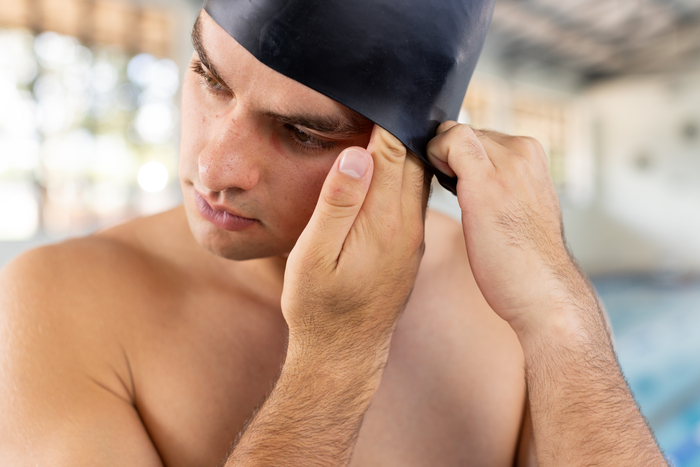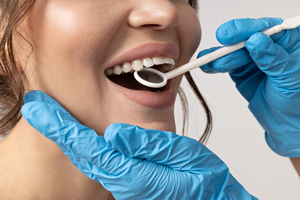Key points
- Swimmer's ear, or otitis externa, is an outer ear infection caused by water trapped in the ear canal, creating a moist environment for bacteria or fungi.
- Swimmers are at higher risk due to frequent exposure to moisture, which breaks down the protective earwax barrier and allows bacteria and fungi to multiply.
- Preventive measures include using waterproof earplugs, ear drops to repel water, avoiding dirty or polluted water, and proper ear care after swimming.
- If symptoms such as severe ear pain, persistent discharge, hearing loss, or systemic symptoms occur, it's important to seek professional medical care promptly.

As summer approaches, many of us look forward to cooling off in the pool or enjoying water sports. However, frequent swimming can increase the risk of ear infections, commonly known as "swimmer’s ear." This condition occurs when water remains trapped in the ear canal, creating a moist environment where bacteria can thrive. Understanding how to prevent swimmer’s ear is essential for keeping your ears healthy and enjoying your time in the water.
What is swimmer’s ear?
Swimmer’s ear, medically known as otitis externa, is an outer ear infection that occurs when water becomes trapped in the ear canal, creating a moist environment ideal for bacterial or fungal growth. This infection affects the skin lining the outer ear canal, causing symptoms like pain, itching, redness, and sometimes discharge.
Unlike a middle ear infection (also known as otitis media), which affects the space behind the eardrum, swimmer’s ear impacts the external auditory canal. Middle ear infections are often linked to respiratory infections, while swimmer’s ear is typically caused by water exposure.
Why are swimmers at higher risk for otitis externa?
Swimmers are particularly susceptible to this condition because their ears are frequently exposed to moisture. When water remains in the ear canal, it can soften and break down the protective earwax barrier, allowing bacteria and fungi to enter and multiply. Warm, humid environments further increase this risk, making swimmer’s ear more common during the summer months.
What causes swimmer’s ear?
Swimmer’s ear develops primarily due to excess moisture in the ear canal, which disrupts the natural protective barrier of earwax and skin. When water becomes trapped inside, it creates a warm, damp environment that promotes the growth of bacteria and fungi, leading to infection.
The most common cause of swimmer’s ear is bacterial infection, particularly from bacteria like Pseudomonas aeruginosa. Fungal infections, while less common, can also occur, especially in individuals with a history of chronic ear conditions or compromised immune systems. Waterlogged ear canals, especially those exposed repeatedly to different water sources, are highly susceptible to these infections.
Activities that increase the risk of swimmer’s ear
Certain activities are more likely to cause water to become trapped in the ears, increasing the risk of swimmer’s ear. These include:
- Swimming in lakes, pools, or oceans: Natural bodies of water often contain bacteria and fungi, while chlorinated pools can alter the ear’s natural pH.
- Diving and water sports: Rapid changes in pressure can force water into the ear canal.
- Frequent showering or bathing: Water can inadvertently enter the ears during routine hygiene practices.
- Using cotton swabs or earplugs improperly: These can push water or earwax deeper into the canal, creating blockages.
Symptoms of swimmer’s ear
Swimmer’s ear can range from mild irritation to a severe infection, and recognizing the symptoms early can help prevent complications. The symptoms often progress through stages, starting with mild discomfort and escalating if left untreated. In the initial stages, swimmer’s ear may present with subtle symptoms. Here are some early signs to watch for:
- Itching in the ear canal: Often the first sign, this itchiness may feel persistent and uncomfortable.
- Redness inside the ear: The skin within the ear canal may appear inflamed or slightly swollen.
- Mild discomfort or pain: You might feel a slight ache, especially when moving your jaw or pulling on your earlobe.
If the condition worsens, symptoms can become more severe and noticeable, such as:
- Increased pain, especially when touching the ear: The ear may become extremely tender, particularly when gently pressing the tragus (the small flap of cartilage in front of the ear canal) or moving the earlobe.
- Fluid discharge (clear or pus): As the infection develops, you may notice drainage from the ear, which can be watery, yellow, or even contain pus.
- Swelling and partial hearing loss: The swelling can cause the ear canal to narrow, leading to muffled hearing or a blocked sensation.
If you notice these symptoms, it’s important to seek medical attention at an urgent care facility to prevent the infection from spreading or becoming more severe.
How to prevent swimmer’s ear
Preventing swimmer’s ear is essential, especially if you spend a lot of time in the water. Taking a few simple precautions before, during, and after swimming can significantly reduce your risk of developing this painful condition.
Before swimming
To minimize the risk of water getting trapped in your ear canal, consider these preventive measures:
- Look for waterproof earplugs that fit snugly and are specifically designed to block water. Silicone and moldable plugs are particularly effective.
- Over-the-counter ear drops formulated to repel water can help keep the ear canal dry. A few drops before swimming create a protective barrier.
- Gently clean your ears before swimming, avoiding cotton swabs that can push wax deeper or cause abrasions.
During swimming
While you are in the water, take precautions to keep your ears safe:
- Avoid swimming in dirty or polluted water, as lakes, rivers, or poorly maintained pools may harbor bacteria and increase the risk of infection.
- Avoid diving deep or jumping with force into water since high-impact water entry can push water forcefully into the ear canal, increasing the chance of moisture retention.
After swimming
Proper ear care after swimming can help prevent water from lingering in the ear canal:
- Gently pat around the outer ear and avoid inserting anything into the canal.
- Lean your head to one side and gently pull your earlobe in different directions to encourage drainage.
- Hold a hairdryer at arm’s length and move it around the ear to gently dry out any remaining water.
Home remedies to soothe symptoms of swimmer’s ear
If you’re experiencing mild symptoms of swimmer’s ear, there are several home remedies that may help alleviate discomfort and promote healing. However, you should remember that if symptoms worsen or persist, it’s essential to seek medical care to prevent complications.
1. A warm compress
Applying a warm compress to the affected ear can help relieve pain and discomfort. Soak a clean cloth in warm (not hot) water, wring out excess water, and fold the cloth. Then, hold the warm compress against the painful ear for 5–10 minutes. The warmth is thought to increase blood circulation and can help reduce inflammation and soothe aching muscles around the ear.
2. Over-the-counter ear drops
For mild cases of swimmer’s ear, OTC ear drops can provide relief. Acetic acid or alcohol-based drops help dry out excess moisture, while antibacterial and antifungal drops can reduce microbial growth. Apply by tilting your head sideways, gently pull the earlobe to open the ear canal, and place the recommended number of drops into the ear. Remain in a tilted position for a few minutes to allow the drops to reach the infected area. Take care not to use these drops if you suspect a ruptured eardrum or have drainage, as it could worsen the infection.
When to See a Doctor for Swimmer’s Ear Symptoms
While mild cases of swimmer’s ear can often be managed at home, there are situations where medical intervention is necessary. Seeking professional care promptly can prevent complications and help resolve the infection more effectively. Here’s how to know if you need to be seen at an urgent care for swimmer’s ear:
1. You have severe ear pain or dulled hearing
If you experience intense pain that continues to worsen or sounds like you’re hearing through a glass of water, it’s essential to see a healthcare provider. Severe discomfort, especially when touching or moving the ear, can also indicate a more advanced infection that may require prescription-strength ear drops or oral antibiotics.
2. Persistent discharge or hearing loss
Clear, yellow, or foul-smelling fluid draining from the ear is a sign of infection that should not be ignored. If the discharge persists despite using over-the-counter treatments, it’s time to consult a doctor. Additionally, partial or complete hearing loss caused by swelling or blockage in the ear canal should be evaluated to rule out complications.
3. Fever or systemic symptoms
If swimmer’s ear is accompanied by fever, chills, or other signs of a systemic infection, it may indicate that the infection has spread beyond the ear canal. In rare cases, untreated swimmer’s ear can lead to malignant otitis externa. This severe infection can affect the bones and tissues around the ear, especially in individuals with diabetes or weakened immune systems.
Find an urgent care near you for swimmer’s ear treatment
If your symptoms of swimmer’s ear are persistent or worsening, it’s important to seek professional medical care. Using Solv, you can easily find nearby urgent care clinics that offer fast, reliable treatment for ear infections — you can also book a same-day appointment online and get the care you need without the wait.
FAQs
What is swimmer's ear and why are swimmers more prone to it?
Swimmer's ear, or otitis externa, is an outer ear infection that occurs when water gets trapped in the ear canal, creating a moist environment where bacteria or fungi can thrive. Swimmers are more susceptible to this condition because their ears are frequently exposed to moisture, which can break down the protective earwax barrier and allow bacteria and fungi to enter and multiply.
What are the symptoms of swimmer's ear?
Symptoms of swimmer's ear can range from mild irritation to a severe infection. Early signs include itching in the ear canal, redness inside the ear, and mild discomfort or pain. If the condition worsens, symptoms can become more severe and noticeable, such as increased pain, fluid discharge from the ear, and swelling leading to partial hearing loss.
How can I prevent swimmer's ear?
To prevent swimmer's ear, take precautions before, during, and after swimming. Before swimming, consider using waterproof earplugs and over-the-counter ear drops that repel water. During swimming, avoid diving deep or jumping with force into water and avoid swimming in dirty or polluted water. After swimming, gently pat around the outer ear and encourage drainage by leaning your head to one side and gently pulling your earlobe in different directions. You can also use a hairdryer to gently dry out any remaining water.
What home remedies can help soothe symptoms of swimmer's ear?
For mild symptoms of swimmer's ear, home remedies such as applying a warm compress to the affected ear can help relieve pain and discomfort. Over-the-counter ear drops can also provide relief by drying out excess moisture and reducing microbial growth. However, if symptoms worsen or persist, it's essential to seek medical care to prevent complications.
When should I seek medical attention for swimmer's ear?
You should seek medical attention for swimmer's ear if you experience severe ear pain or dulled hearing, persistent discharge or hearing loss, or if swimmer's ear is accompanied by fever, chills, or other signs of a systemic infection. These could indicate that the infection has spread beyond the ear canal and requires professional medical intervention.









